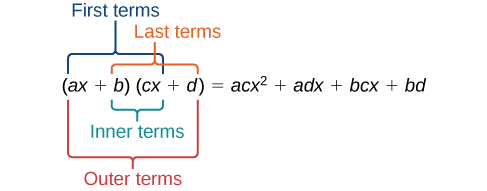Learning Outcomes
- Multiply a polynomial by a monomial
- Multiply binomials – FOIL
- Multiply polynomials – single variable
- Convert between radical and exponent notations
- Use the zero product principle to solve quadratic equations that can be factored
In the Differentiation Rules section, you will learn methods that will allow you to find the derivative of a function quicker. Here we will review some basic algebraic principles including how to multiply polynomials and write radicals in exponential form. How to solve quadratic equations by factoring will also be discussed.
Multiply Polynomials
To multiply a number by a polynomial, we use the distributive property. The number must be distributed to each term of the polynomial. In [latex]2\left(x+7\right)[/latex] we can distribute [latex]2[/latex] to obtain the expression [latex]2x+14[/latex]. When multiplying polynomials, the distributive property allows us to multiply each term of the first polynomial by each term of the second. We then add the products together and combine like terms to simplify.
How To: Given the multiplication of two polynomials, use the distributive property to simplify the expression
- Multiply each term of the first polynomial by each term of the second.
- Combine like terms.
- Simplify.
Example: Multiplying Polynomials Using Distributive Property
Find the product.
[latex]\left(2x+1\right)\left(3{x}^{2}-x+4\right)[/latex]
Try It
Watch this video to see more examples of how to use the distributive property to multiply polynomials.
You can view the transcript for “Ex: Multiplying Using the Distributive Property” here (opens in new window).
A shortcut called FOIL is sometimes used to find the product of two binomials. It is called FOIL because we multiply the first terms, the outer terms, the inner terms, and then the last terms of each binomial.

The FOIL method is simply just the distributive property. We are multiplying each term of the first binomial by each term of the second binomial and then combining like terms.
How To: Given two binomials, Multiplying Using FOIL
- Multiply the first terms of each binomial.
- Multiply the outer terms of the binomials.
- Multiply the inner terms of the binomials.
- Multiply the last terms of each binomial.
- Add the products.
- Combine like terms and simplify.
Example: Multiplying Polynomials Using FOIL
Use FOIL to find the product.
[latex]\left(2x-18\right)\left(3x + 3\right)[/latex]
Try It
Convert Between Radical and Exponential Form
Radical expressions can also be written without using the radical symbol. We can use rational (fractional) exponents. The index must be a positive integer. If the index [latex]n[/latex] is even, then [latex]a[/latex] cannot be negative.
We can also have rational exponents with numerators other than 1. In these cases, the exponent must be a fraction in lowest terms. We raise the base to a power and take an nth root. The numerator tells us the power and the denominator tells us the root.
All of the properties of exponents that we learned for integer exponents also hold for rational exponents.
Rational Exponents
Rational exponents are another way to express principal nth roots. The general form for converting between a radical expression with a radical symbol and one with a rational exponent is
How To: Given an expression with a rational exponent, write the expression as a radical.
- Determine the power by looking at the numerator of the exponent.
- Determine the root by looking at the denominator of the exponent.
- Using the base as the radicand, raise the radicand to the power and use the root as the index.
Example: Converting from radical to exponential form
Write [latex]\sqrt[3]{{x}^{2}}[/latex] with a rational exponent.
Try It
Write [latex]\sqrt{{y}^{5}}[/latex] with a rational exponent.
Example: Converting From Radical To Exponential Form In a Rational Expression
Write [latex]\dfrac{4}{\sqrt[7]{{a}^{2}}}[/latex] using a rational exponent.
Try It
Write [latex]x\sqrt{{\left(5y\right)}^{9}}[/latex] using a rational exponent.
Solve Quadratic Equations by Factoring
An equation containing a second-degree polynomial is called a quadratic equation. For example, equations such as [latex]2{x}^{2}+3x - 1=0[/latex] and [latex]{x}^{2}-4=0[/latex] are quadratic equations. Often, the easiest method of solving a quadratic equation is by factoring.
How To: Given a quadratic equation, Solve it by factoring
- Set the quadratic equation equal to 0.
- Factor.
- Set each factor equal to 0 and solve for the variable.
Example: Solving A Quadratic Equation by Factoring
Factor and solve the equation: [latex]{x}^{2}+x - 6=0[/latex].
Try It
Factor and solve the quadratic equation: [latex]{x}^{2}-5x - 6=0[/latex].
Try It
Candela Citations
- Modification and Revision. Provided by: Lumen Learning. License: CC BY: Attribution
- Precalculus. Provided by: Lumen Learning. Located at: https://courses.lumenlearning.com/precalculus/. License: CC BY: Attribution
- College Algebra Corequisite. Provided by: Lumen Learning. Located at: https://courses.lumenlearning.com/waymakercollegealgebracorequisite/. License: CC BY: Attribution




